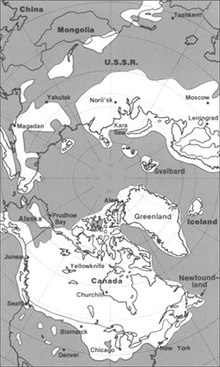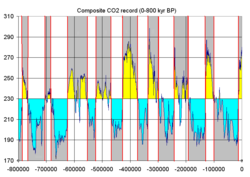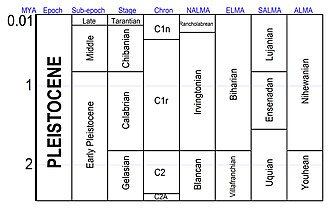A tipping point in the climate system is a threshold that, when exceeded, can lead to large changes in the state of the system. Potential tipping points have been identified in the physical climate system, in impacted ecosystems, and sometimes in both. For instance, feedback from the global carbon cycle is a driver for the transition between glacial and interglacial periods, with orbital forcing providing the initial trigger. Earth's geologic temperature record includes many more examples of geologically rapid transitions between different climate states.
Climate tipping points are of particular interest in reference to concerns about global warming in the modern era. Possible tipping point behaviour has been identified for the global mean surface temperature by studying self-reinforcing feedbacks and the past behavior of Earth's climate system. Self-reinforcing feedbacks in the carbon cycle and planetary reflectivity could trigger a cascading set of tipping points that lead the world into a hothouse climate state.
Large-scale components of the Earth system that may pass a tipping point have been referred to as tipping elements. Tipping elements are found in the Greenland and Antarctic ice sheets, possibly causing tens of meters of sea level rise. These tipping points are not always abrupt. For example, at some level of temperature rise the melt of a large part of the Greenland ice sheet and/or West Antarctic Ice Sheet will become inevitable; but the ice sheet itself may persist for many centuries. Some tipping elements, like the collapse of ecosystems, are irreversible.
Definition
The IPCC AR5 defines a tipping point as an irreversible change in the climate system. It states that the precise levels of climate change sufficient to trigger a tipping point remain uncertain, but that the risk associated with crossing multiple tipping points increases with rising temperature. A broader definition of tipping points is sometimes used as well, which includes abrupt but reversible tipping points.
In the context of climate change, an "adaptation tipping point" has been defined as "the threshold value or specific boundary condition where ecological, technical, economic, spatial or socially acceptable limits are exceeded."
Tipping point behaviour in the climate can also be described in mathematical terms. Tipping points are then seen as any type of bifurcation with hysteresis. Hysteresis is the dependence of the state of a system on its history. For instance, depending on how warm and cold it was in the past, there can be differing amounts of ice present on the poles at the same concentration of greenhouse gases or temperature.
In a study inspired by "mathematical and statistical approaches to climate modelling and prediction", the authors identify three types of tipping points in open systems such as the climate system—bifurcation, noise-induced and rate-dependent. The idea of tipping points in climate science, as indicated by palaeoclimate data and global climate models, suggest that the "climate system may abruptly 'tip' from one regime to another in a comparatively short time."
Bifurcation-induced tipping refers to changes in dynamical systems that occur when a small smooth change made to bifurcation parameters of the system causes an abrupt or sudden topological change in the behavior of the system. In the Atlantic Meridional Overturning Circulation (AMOC), slow passage to the bifurcation parameters—the salinity, temperature and density of water—could cause the AMOC to abruptly collapse when it reaches a critical tipping point. Currents of warm, seawater in the upper layers of the Atlantic flow north, while currents of colder, deep waters from the North Atlantic flow south, like a conveyor belt known as thermohaline circulation. Downwelling occurs when the warmer, higher-density seawater accumulates and sinks beneath the colder, lower density less saline water from glacier melt. An AMOC collapse would occur if downwelling was inhibited. [critical slowing down] (CSD) "occurs because a restoring feedback is weakening as a bifurcation-type tipping point is approached."
Noise-induced tipping refers to transitions due to random fluctuations or internal variability of the system, as in the Dansgaard-Oeschger events during the last glacial period, with 25 occurrences of rapid climate fluctuations.
Rate-induced tipping occurs in an "excitable system"—such as peatlands—when one of the systems parameters is "ramped" through a "steady, slow and monotonic change" eliciting a "large excitable response". In the case of peatlands, the rate-induced tipping point results in an "explosive release of soil carbon from peatlands into the atmosphere"—"compost bomb instability".
Tipping points for global temperature
There are many positive and negative feedbacks to global temperatures and the carbon cycle that have been identified. The IPCC reports that feedbacks to increased temperatures are net positive for the remainder of this century, with the impact of cloud cover the largest uncertainty. IPCC carbon cycle models show higher ocean uptake of carbon corresponding to higher concentration pathways, but land carbon uptake is uncertain due to the combined effect of climate change and land use changes.
The geologic record of temperature and greenhouse gas concentration allows climate scientists to gather information on climate feedbacks that lead to different climate states, such as the Late Quaternary (past 1.2 million years), the Pliocene period five million years ago and the Cretaceous period, 100 million years ago. Combining this information with the understanding of current climate change resulted in the finding that "A 2 °C warming could activate important tipping elements, raising the temperature further to activate other tipping elements in a domino-like cascade that could take the Earth System to even higher temperatures".
The speed of tipping point feedbacks is a critical concern and the geologic record often fails to provide clarity as to whether past temperature changes have taken only a few decades or many millennia of time. For instance, a tipping point that was once feared to be abrupt and overwhelming is the release of clathrate compounds buried in seabeds and seabed permafrost, but that feedback is now thought to be chronic and long term.
Some individual feedbacks may be strong enough to trigger tipping points on their own. A 2019 study predicts that if greenhouse gases reach three times the current level of atmospheric carbon dioxide that stratocumulus clouds could abruptly disperse, contributing an additional 8 degrees Celsius of warming.
Runaway greenhouse effect
The runaway greenhouse effect is used in astronomical circles to refer to a greenhouse effect that is so extreme that oceans boil away and render a planet uninhabitable, an irreversible climate state that happened on Venus. The IPCC Fifth Assessment Report states that "a 'runaway greenhouse effect' —analogous to Venus— appears to have virtually no chance of being induced by anthropogenic activities." Venus-like conditions on the Earth require a large long-term forcing that is unlikely to occur until the sun brightens by a few tens of percents, which will take a few billion years.
While a runaway greenhouse effect on Earth is virtually impossible, there are indications that Earth could enter a moist greenhouse state that renders large parts of Earth uninhabitable if the climate forcing is large enough to make water vapour (H2O) a major atmospheric constituent. Conceivable levels of human-made climate forcing would increase water vapour to about 1% of the atmosphere's mass, thus increasing the rate of hydrogen escape to space. If such a forcing were entirely due to CO2, the weathering process would remove the excess atmospheric CO2 well before the ocean was significantly depleted.
Tipping elements
Large scale tipping elements
A smooth or abrupt change in temperature can trigger global-scale tipping points. In the cryosphere these include the irreversible melting of Greenland and Antarctic ice sheets. In Greenland, a positive feedback cycle exists between melting and surface elevation. At lower elevations, temperatures are higher, leading to additional melting. This feedback loop can become so strong that irreversible melting occurs. Marine ice sheet instability could trigger a tipping point in West Antarctica. Crossing either of these tipping points leads to accelerated global sea level rise.
When fresh water gets released as a consequence of Greenland melting, a threshold may be crossed which leads to disruption of the thermohaline circulation. The thermohaline circulation transports heat northward which is important for temperature regulation in the Atlantic region. Risks for a complete shutdown are low to moderate under the Paris agreement levels of warming.
Other examples of possible large scale tipping elements are a shift in El Niño–Southern Oscillation. After crossing a tipping point, the warm phase (El Niño) would start to occur more often. Lastly, the southern ocean, which now absorbs a lot of carbon, might switch to a state where it does not do this anymore.
Regional tipping elements
Climate change can trigger regional tipping points as well. Examples are the disappearance of Arctic sea ice, the establishment of woody species in tundra, permafrost loss, the collapse of the monsoon of South Asia and a strengthening of the West African monsoon which would lead to greening of the Sahara and Sahel. Deforestation may trigger a tipping point in rainforests (i.e. Savannization in the Amazon rainforest, ...). As rain forests recycle a large part of their rainfall, when a portion of the forest is destroyed local droughts may threaten the remainder. Finally, boreal forests are considered a tipping element as well. Local warming causes trees to die at a higher rate than before, in proportion to the rise in temperature. As more trees die, the woodland becomes more open, leading to further warming and making forests more susceptible to fire. The tipping point is difficult to predict, but is estimated to be between 3–4 °C of global temperature rise.
Cascading tipping points
Crossing a threshold in one part of the climate system may trigger another tipping element to tip into a new state. These are so-called cascading tipping points. Ice loss in West Antarctica and Greenland will significantly alter ocean circulation. Sustained warming of the northern high latitudes as a result of this process could activate tipping elements in that region, such as permafrost degradation, loss of Arctic sea ice, and Boreal forest dieback. This illustrates that even at relatively low levels of global warming, relatively stable tipping elements may be activated.
Timothy Lenton at Exeter University, England and his team of researchers, had first warned in their landmark 7 February 2008 PNAS paper, about the "risks of climate tipping points." In 2008, Lenton and his team "thought the dangers would only arise when global warming exceeded 5 degrees Celsius (9 degrees Fahrenheit) above pre-industrial levels." A new study published in Nature on 27 November 2019 by Lenton and 6 co-authors, warned in language that is "much starker" than the Intergovernmental Panel on Climate Change's forecasts, that risks are "much more likely and much more imminent" and that some "may already have been breached."
Early warning signals
For some of the tipping points described above, it may be possible to detect whether that part of the climate system is getting closer to a tipping point; however, detection can note only that abrupt changes are likely, while predicting when and where they will occur remains difficult. A premier mode of detection for these warning signals is through natural archives like sediments, ice caps, and tree rings, where past changes in climate can be observed. All parts of the climate system are sometimes disturbed by weather events. After the disruption, the system moves back to its equilibrium. A storm may damage sea ice, which grows back after the storm has passed. If a system is getting closer to tipping, this restoration to its normal state might take increasingly longer, which can be used as a warning sign of tipping.
Changes in the Arctic
A 2019 UNEP study indicates that now at least for the Arctic and the Greenland ice sheet a tipping point has already been reached. Because of dewing of permafrost soil, more methane (in addition to other short-lived climate pollutant) could enter the atmosphere earlier than previously predicted and the loss of reflecting ice shields has started a powerful positive feedback loop leading to ever higher temperatures. The resulting accelerating climate instability in the polar region has potential to affect the global climate, outdating previous predictions about the point in the future when global tipping will occur.
A more regional tipping point may have already been reached in the form of a mass recession of Arctic sea ice. According to scientist Ron Lindsay at the University of Washington Applied Physics Laboratory, a tipping point in the Arctic materializes as a positive feedback loop, where "increased summer melt means decreased winter growth and then even more melting the next summer, and so on." The loss of Arctic sea ice, while detrimental to the region, also holds severe consequences for the rest of the globe. Critically important is the role of sea ice in increasing the Earth's albedo, or reflectivity. Sea ice has an albedo level of 0.5 to 0.7, reflecting fifty to seventy percent of incoming energy, while the ocean beneath has an albedo of only .06, reflecting only six percent of incoming energy. As sea ice decreases and exposes the less reflective ocean, albedo decreases across the region. Summer sea ice is of particular importance, reflecting approximately fifty percent of incoming radiation back into space at a time when there is already an increase in daylight in the Arctic. NOAA (National Oceanic and Atmospheric Administration) notes that in September 2019, "the sea ice cover reached its annual summer minimum, tying with 2007 and 2016 for second-smallest on record."
In June 2019, satellite images from around the Arctic showed burning fires that are farther north and of greater magnitude than at any time in the 16-year satellite record, and some of the fires appear to have ignited peat soils. Peat is an accumulation of partially decayed vegetation and is an efficient carbon sink. Scientists are concerned because the long-lasting peat fires release their stored carbon back to the atmosphere, contributing to further warming. The fires in June 2019, for example, released as much carbon dioxide as Sweden's annual greenhouse gas emissions.
Tipping point effects
If the climate tips into a hothouse Earth scenario, some scientists warn of food and water shortages, hundreds of millions of people being displaced by rising sea levels, unhealthy and unlivable conditions, and coastal storms having larger impacts. Runaway climate change of 4–5 °C can make swathes of the planet around the equator uninhabitable, with sea levels up to 60 metres (197 ft) higher than they are today. Humans cannot survive if the air is too moist and hot, which would happen for the majority of human populations if global temperatures rise by 11–12 °C, as land masses warm faster than the global average. Effects like these have been popularized in books like The Uninhabitable Earth and The End of Nature.















